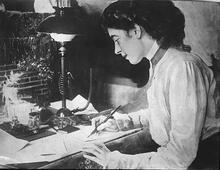Rose Wortis
Rose Wortis was born in Ukraine but moved to New York City at the age of 8. To help support her family, she worked in the needle trades for over 15 years while also attending night school. She joined the International Ladies Garment Workers Union and served as an elected official of the complaints department. She was also a member of the Socialist Party until the Bolshevik Revolution fragmented the party, after which she became a communist activist. She was elected secretary of the Trade Union Unity League in 1929 and also served as secretary to the Needle Trades Workers Industrial Union. She became a well-known speaker and writer on labor issues. In the 1930s, she became more open about her communist affiliations, declaring her position as the New York District Communist Party’s secretary. However, she spent much of the 1940s and early 1950s defending herself against anticommunist attack, until her death in 1958.
Early Life and ILGWU
Rose Wortis was an Eastern European immigrant needleworker who devoted her life to working-class organizing and the Left.
The fourth of six daughters of Samuel Shadduck and Chia Wortis, she was born in August 1895 in the village of Krasilov in the Ukraine, then the Pale of Settlement. She came to Brooklyn, New York, in 1908, living in a household with her mother’s relatives, working in a blouse factory, and attending school at night, including evening high school from 1911 to 1915. Wortis worked as an operator in the needle trades at least until 1925, and like many other immigrant Jewish women needleworkers, she joined Local 25 of the International Ladies Garment Workers Union (ILGWU), where she later served as an elected official of the complaints department. In 1925, she began to work as an organizer for the ILGWU.
In the Communist Party
In the 1910s, Wortis, like many other Jewish men and women in her Williamsburg, Brooklyn, neighborhood, was active in the Socialist Party until it fragmented due to political differences regarding the implications of the Bolshevik Revolution and the role of foreign-language federations. At that point (1919), Wortis became a charter member of the Communist Party of the United States of America. From 1915 to 1925, Wortis struggled to create a leftist presence within the ILGWU, attempting to return union leadership to the shop floor (with more guidance from communist activists), and to mobilize against the ILGWU’s attempts to expel leftist militants from union locals.
When leftist activists convened the Trade Union Unity League in 1929 to promote the organization of industrywide unions, Wortis was elected secretary. She also served as secretary in the leftist Needle Trades Workers Industrial Union during the years in which this organization competed with the ILGWU. In 1934, Wortis ran for New York State Controller on the Communist Party ticket. Other communists active in the labor movement and in the needle trades remembered her in the 1930s as “always foremost on the picket lines .. . always coming up with constructive advice, how to work in strikes, how to organize.” Wortis became well known as a public speaker and as a writer in Yiddish and English, especially on labor issues. Her articles appeared in the Communist Party’s daily paper, the Daily Worker, the party’s theoretical journal, The Communist, and in the Yiddish communist daily newspaper, Oifrayheyt.
In an entry in Who’s Who in American Jewry (probably based on a questionnaire she filled out), Wortis suggested how she wanted to present herself to the Jewish community in 1938. She identified herself foremost as a labor organizer, supported by her membership in the Dressmakers Executive Board and on the strike committee of the ILGWU. She positioned herself on the left of the labor movement by noting her activities in the leftist Trade Union Educational League and its affiliated Needle Trades Workers Industrial Union. Making use of the Communist Party’s new public openness after 1935 as part of its participation in New Deal and labor coalitions, she noted her own party leadership as secretary of the labor department for the New York District Communist Party. Her listing of her membership in the International Workers Order (IWO), a fraternal association with leftist ties, was probably an indication of her activity in the Jewish People’s Fraternal Order, the IWO’s huge Jewish section.
Later Life Struggles
In the 1940s, Wortis was probably active in the Communist Party’s attempt to encourage left-wing and antiracist union activity, although after 1947, the emergence of red-baiting made it harder to work publicly as a communist. In the 1950s, communist activists like Wortis had to spend most of their time defending themselves and their organizations from anticommunist legal and political attack. By the early 1950s, Wortis was increasingly disabled by rheumatoid arthritis, and after several years “on a bed of anguish,” she died in New York in 1958.
“Communists Pick Ticket,” NYTimes, August 25, 1934, 2.
Dixler, Elsa. “The Woman Question: Women and the American Communist Party, 1929–1941.” Ph.D. diss., Yale University, 1974.
Encyclopedia of the American Left. Edited by Mari Jo Buhle, Paul Buhle, and Dan Georgakas (1990), s.v. “Communist Party,” and “International Ladies Garment Workers Union,” and “International Workers Order,” and “Rose Wortis (1886–1958),” and “Trade Union Unity League.”
Foner, Philip. Women and the American Labor Movement: From the First Trade Unions to the Present (1979).
Hardy, Jack. The Clothing Workers: A Study of Conditions and Struggles in the Needle Trades (1935).
Isserman, Maurice. Which Side Were You On? The American Communist Party During the Second World War (1982).
Keeran, Roger. “National Groups and the Popular Front: The Case of the International Workers Order.” Journal of American Ethnic History 14 (1995).
Klehr, Harvey. The Heyday of American Communism: The Depression Decade (1984).
North, Joseph. “Memories of Rose Wortis Bloom Among Her Friends.” Daily World, March 10, 1972.
Ottanelli, Fraser M. The Communist Party of the United States: From the Depression to WWII (1991).
“Rose Wortis: In Memoriam. Jewish Currents 13 (February 1959): 28.
WWIAJ (1938).



